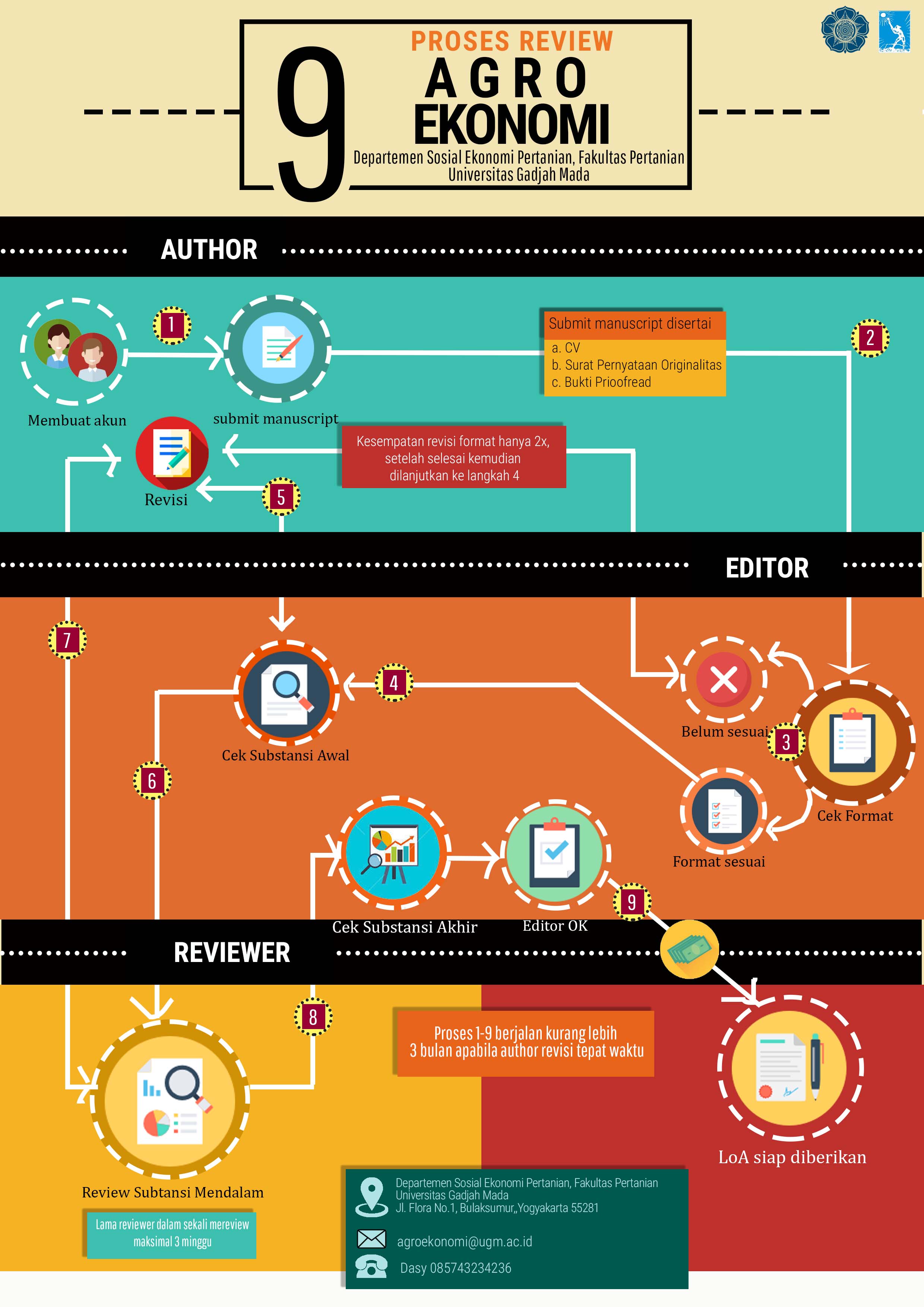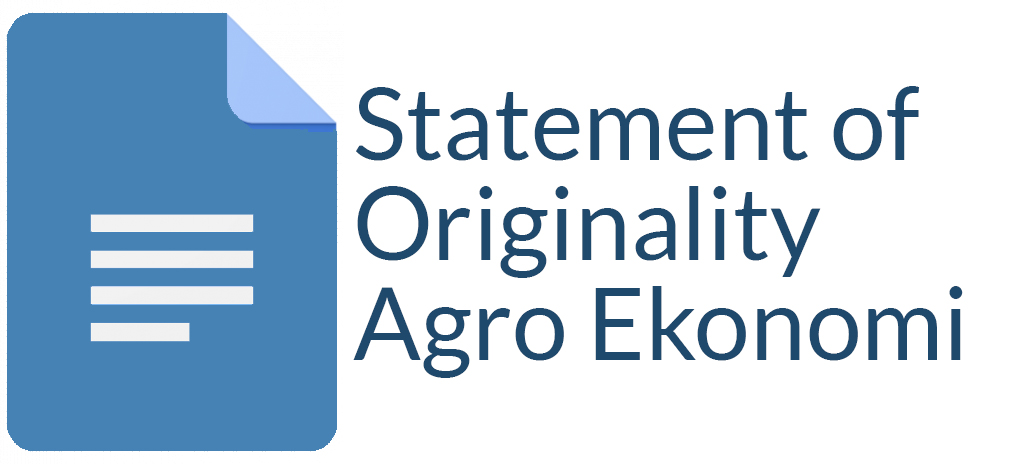Relationship of 7P Marketing Mix and Consumers' Loyalty in Traditional Markets
Hariyani Dwi Anjani(1*), Irham Irham(2), Lestari Rahayu Waluyati(3)
(1) Master Program in Agribusiness Management, Universitas Gadjah Mada
(2) Faculty of Agriculture, Universitas Gadjah Mada
(3) Faculty of Agriculture, Universitas Gadjah Mada
(*) Corresponding Author
Abstract
The existence of the traditional market as a center of most people’s economic activities in Indonesian society has begun to be displaced by the modern market. Improvement in service quality is important in increasing consumers’ loyalty in order to retain them. The purposes of this research are: 1) to know the level of marketing mix of (Product, Price, Place, Promotion, People, Process, in 7P traditional market; 2) to know the level of traditional market consumer’s loyalty of and 3) to determine the relationship between marketing mix implementation with consumer’s loyalty. There were 180 traditional market consumers selected by incidental sampling method from 8 traditional markets in 6 districts among 5 provinces all over Indonesia. Checklists and Likert scale questionnaires were used as tools in this study. Descriptive method was used to analyze data. Based on analysis results, it is known that, according to the consumers, the level of marketing mix implementation in traditional markets is high with an average value of 74.07%. The marketing mix elements in order to arrange from the highest to the lowest level of implementation are respectively those termed People, Process, Physical Evidence, Price, Place, Product, and Promotion. The People element is the highest in level. This shows that traders’ friendliness, alacrity, and honesty are still the hallmarks of traditional markets. The Promotion element is the lowest in level because most of the merchants do not implement proper promotion. The average of consumers’ loyalty level in traditional markets is 77.61%, which is considered high in the category. The 7P’s marketing mix, except for the Product aspect, have a positive and significant correlation with consumer loyalty, but it is still relatively weak. The consumers would continue to repurchase in the traditional markets and recommend that others also shop there.
Keywords
Full Text:
PDFReferences
Agic, E., Cinjarevic, M., Kurtovic, E., & Cicic, M. (2016). Strategic marketing patterns and performance implications. European Journal of Marketing, 50(12), 2216–2248. https://doi.org/10.1108/EJM-08-2015-0589
Brooks, N., & Simkin, L. (2012). Judging marketing mix effectiveness. Marketing Intelligence & Planning, 30(5), 494–514. https://doi.org/10.1108/02634501211251025
Harrington, R. J., Ottenbacher, M. C., & Fauser, S. (2017). QSR brand value. International Journal of Contemporary Hospitality Management, 29(1), 551–570. https://doi.org/10.1108/IJCHM-06-2015-0300
Kasiri, L. A., Guan Cheng, K. T., Sambasivan, M., & Sidin, S. M. (2017). Integration of standardization and customization: Impact on service quality, customer satisfaction, and loyalty. Journal of Retailing and Consumer Services, 35(June 2016), 91–97.
Khan,M.(2014). The Concept of Marketing Mix and its Elements (A Conceptual Review) International Journal of Information, Business and Management, 6(2), 95–107.
Kotler, P., & Keller, K. L. (2009). Manajemen Pemasaran. Jakarta: Penerbit Erlangga.
Kukanja, M., Omerzel, D. ., & Kodrič, B. (2016). Ensuring restaurant quality and guests’ loyalty: an integrative model based on marketing (7P) approach,. Total Quality Management & Business Excellence, 1–17.
Kushwaha, G. S., & Agrawal, S. R. (2015). An Indian customer surrounding 7Ps of service marketing. Journal of Retailing and Consumer Services, 22, 85–95. https://doi.org/10.1016/j.jretconser.2014.10.006
Lamberti, L., & Noci, G. (2010). Marketing strategy and marketing performance measurement system : Exploring the relationship. European Management Journal, 28(2), 139–152. https://doi.org/10.1016/ j.emj.2009.04.007
Lee, S. (2017). Study on Traditional Market Decline and Revitalization in Korea: Improving the Iksan Jungang Traditional Market. Journal of Asian Architecture and Building Engineering, 455–462.
Marques, A., Lacerda, D. P., Camargo, L. F. R., & Teixeira, R. (2014). Exploring the relationship between marketing and operations: Neural network analysis of marketing decision impacts on delivery performance. International Journal of Production Economics, 153, 178–190. https://doi.org/10.1016/ j.ijpe.2014.02.020
Merrilees, B., Rundle-thiele, S., & Lye, A. (2011). Industrial Marketing Management Marketing capabilities : Antecedents and implications for B2B SME performance. Industrial Marketing Management, 40(3), 368–375.
Nielsen (2015). Maximising Traditions : The Shop. Shopper. Shopkeeper. The Nielsen Company, (October).
Orel, F. D., & Kara, A. (2014). Supermarket self-checkout service quality, customer satisfaction, and loyalty: Empirical evidence from an emerging market. Journal of Retailing and Consumer Services, 21(2), 118–129.
Picón-Berjoyo, A., Ruiz-Moreno, C., & Castro, I. (2016). A mediating and multigroup analysis of customer loyalty. European Management Journal, 34(6), 701–713. https://doi.org/10.1016/j.emj.2016.07.006
Pramono, A., Santoso, A., & Indriyono, P. (2011). Menahan Serbuan Pasar Modern : Strategi Perlindungan dan Pengembangan Pasar Tradisional. Lembaga Ombudsman Swasta DIY.
Rahmaningtyas, A., Hartono, S., & Suryantini, A. (2017). Factors Affecting Online Purchasing of Local Food. Agro Ekonomi, 28(2), 189–204.
Rathee, S., & Kumar, J. (2013). Rural Marketing Environment : A Conceptual Framework. Asia Pasific Journal of Marketing & Management Review, 2(9), 64–74.
Selang, C. A. D. (2013). Bauran Pemasaran. Pengaruhnya terhadap Loyalitas Konsumen pasa Fresh Mart Buhu Mall Manado. Jurnal EMBA 71, 1(3), 71–80.
Singh, P. (2015). Marketing Mix Strategies for FMCG in Rural India A Competitive Player in FMCG. Global Journal of Enterprise Information System, 2–6.
Srivastava, M., & Kaul, D. (2016). Exploring the link between customer experience-loyalty-consumer spend. Journal of Retailing and Consumer Services, 31, 277–286. https://doi.org/10.1016/j.jretconser.2016.04.009
Suryadarma, D., Poesoro, A., Budiyati, S., Rosfadhila, M., & Suryahadi, A. (2010). Traditional food traders in developing countries and competition from supermarkets : Evidence from Indonesia. Food Policy, 35(1), 79–86. https://doi.org/10.1016/j.foodpol.2009.11.002
Terho, H., & Jalkala, A. (2017). Customer reference marketing: Conceptualization, measurement and link to selling performance. Industrial Marketing Management, 64, 175–186. https://doi.org/10.1016/ j.indmarman.2017.01.005
Tjiptono, F., & Chandra, G. (2005). Service, Quality, and Satisfaction. Yogyakarta: Penerbit Andi.
World Bank, & Trade Department of Republic Indonesia. (2007). Survey of Consumers Shopping Behavior and Perceptions toward Modern and Traditional Trade Channels. Jakarta: Trade Department of Republik Indonesia.
Yarimoglu, E. K. (2014). A review on dimensions of service quality models. Journal of Marketing Management, 2(2), 73–93.
Article Metrics
Refbacks
- There are currently no refbacks.
Copyright (c) 2018 Agro Ekonomi

This work is licensed under a Creative Commons Attribution-ShareAlike 4.0 International License.
View My Stats











